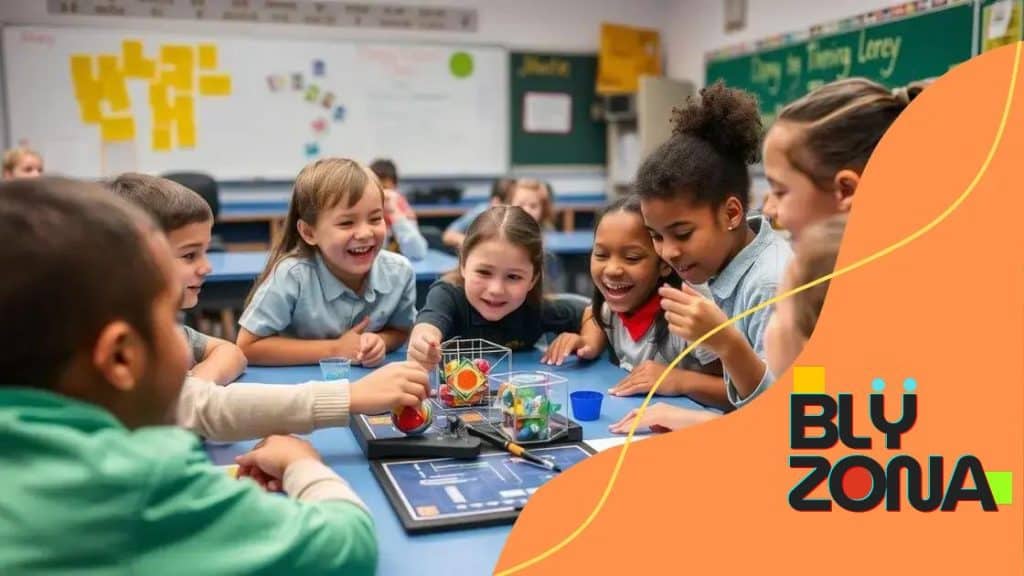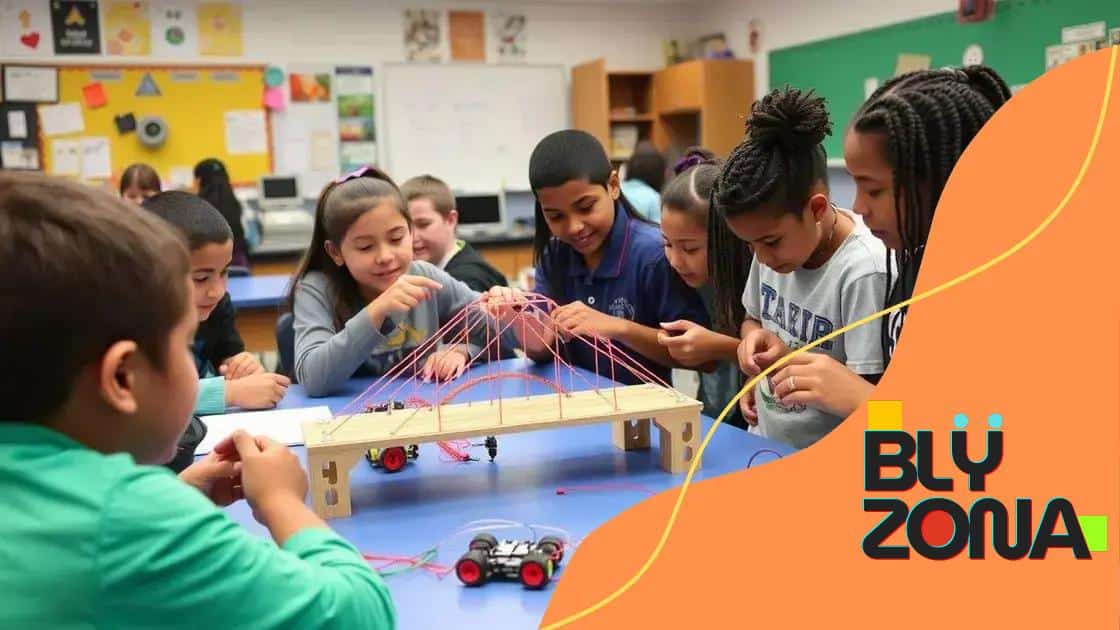Gamified STEM challenges for K-12 students: engage and learn

Gamified STEM challenges enhance student engagement and learning outcomes by incorporating game elements that motivate students to actively participate in their education, fostering critical thinking and collaboration.
Gamified STEM challenges for K-12 students offer a playful way to spark interest in science, technology, engineering, and math. Have you ever wondered how these fun activities can enhance learning outcomes? Let’s dive into the exciting world of gamification in education.
Understanding gamification in education
Understanding gamification in education is crucial for enhancing student engagement. It involves using game-like elements to make learning more interactive and fun. This approach can transform ordinary lessons into exciting challenges.
What is Gamification?
Gamification introduces elements such as points, badges, and leaderboards into educational contexts. This creates a competitive environment that motivates students to participate actively in their learning journey.
Key Benefits
- Increased motivation to learn
- Enhanced collaboration among students
- Improved retention of information
- Development of critical thinking skills
By incorporating game dynamics, educators can help students view challenges positively. They become more willing to take risks and explore new ideas. This shift not only fosters a love for learning but also prepares students for real-world problem solving.
Technology plays a vital role in facilitating gamified learning experiences. With various online platforms and apps available, teachers can easily implement these strategies in their classrooms. For example, using interactive quizzes and simulations allows students to learn in a safe environment where mistakes are simply part of the process.
Examples in Practice
Many schools have already adopted gamification to great effect. For instance, students can earn rewards for completing tasks or mastering skills, which motivates them to strive for excellence. Additionally, classroom competitions can ignite excitement around specific subjects like math or science.
As we embrace gamification, it’s important to consider its integration into curricula thoughtfully. Teachers must balance game elements with traditional instruction to ensure that educational goals remain the priority. Keeping this in mind will help foster an enriching learning environment.
Benefits of gamified STEM challenges
The benefits of gamified STEM challenges are numerous and can significantly enhance the educational experience. These challenges engage students and encourage them to participate actively in their learning.
Why Gamification Works
Gamification taps into our innate desire for achievement and competition. By incorporating game-like elements, students become motivated to reach their learning goals. They feel rewarded when they complete tasks and earn points, which boosts their confidence.
Key Advantages
- Increased Engagement: Gamified challenges keep students interested in STEM subjects.
- Better Retention: Students remember information better when it’s presented in a fun way.
- Collaboration: Many challenges encourage teamwork, helping students develop social skills.
- Critical Thinking: These challenges require problem-solving skills, pushing students to think deeply.
Additionally, students who participate in gamified learning often collaborate with their peers. This collaboration fosters a sense of community in the classroom, allowing learners to connect and share ideas. As they tackle challenges together, students enhance their communication skills and learn from each other.
To illustrate, consider a STEM challenge where students design a simple bridge. This project combines engineering concepts with creativity and teamwork. As they work through the design process, they are not only learning important academic concepts but also enjoying the experience. Such activities help students apply their knowledge in practical situations.
Long-Term Impact
The impact of gamified STEM challenges extends beyond the classroom. Students develop a positive attitude towards learning that can influence their future education choices. The skills they acquire, such as adaptability and critical thinking, prepare them for various fields in the STEM workforce.
As more educators recognize the value of gamification, we can expect to see it grow in popularity. Implementing these challenges creates a vibrant learning environment where students are eager to explore and innovate.
Examples of effective STEM challenges

Examples of effective STEM challenges provide educators with practical ideas to enhance student learning. These challenges can engage students and spark their interest in science, technology, engineering, and math. Let’s explore a few that have proven successful.
Building Bridges
In this challenge, students design and construct a bridge using limited materials like straws, popsicle sticks, or paper. They must consider factors like weight, stability, and aesthetics. This project encourages teamwork while teaching engineering principles.
Robotics Competition
Another exciting challenge involves robotics. Students can participate in competitions where they program robots to complete specific tasks. This hands-on experience not only cultivates coding skills but also fosters critical thinking and creativity.
- Teamwork: Students learn to work together effectively.
- Problem Solving: They face challenges that require innovative solutions.
- Technical Skills: Students gain hands-on experience with technology.
Through these types of challenges, students gain practical skills that are essential in today’s world. For instance, while building bridges, they learn about forces, tension, and materials science. They might encounter setbacks but will also discover the importance of perseverance and iterative design.
Science Experiments
Implementing engaging science experiments also counts as a STEM challenge. Students can explore concepts like chemical reactions by creating simple volcanoes or exploring physics through egg drops. These experiments provide instant feedback and spark curiosity.
These challenges show how effective STEM education can be. By integrating fun and creativity into the learning process, students are more likely to remain engaged and inspired. Experimenting with real-world scenarios helps students connect their education to future opportunities.
Tips for implementing gamified learning
Implementing gamified learning in the classroom can be an exciting way to boost student engagement and understanding. Here are some effective tips to get started.
Start Simple
Begin with one or two game elements instead of overhauling your entire curriculum. Adding small features, like points for participation or badges for achievements, can motivate students without overwhelming them.
Incorporate Group Work
Gamified learning often thrives on collaboration. Encourage teamwork by having students work in groups to complete challenges. This not only fosters communication skills but also helps students learn from one another.
- Promote Creative Thinking: Allow students to develop their unique solutions.
- Encourage Friendly Competition: Set up challenges where groups can compete to earn points.
- Celebrate Success: Acknowledge both individual and group achievements to foster a positive atmosphere.
Another effective way to implement gamified learning involves clear objectives. Establish goals for each challenge that align with learning outcomes. When students understand what they need to achieve, they can focus their efforts effectively.
Use Technology
Leverage technology to support gamified learning experiences. There are various apps and platforms designed specifically for this purpose, making it easier to track progress and rewards. For example, using an online leaderboard can create a sense of competition among students.
These tools can simplify the implementation process and provide instant feedback. Students are more likely to stay engaged when they can see their progress in real-time, turning learning into a fun experience.
As you implement these strategies, remember to adjust based on your students’ needs. Collect feedback regularly and be open to making changes. This flexibility will help you create an effective gamified learning environment that benefits all students.
Measuring the impact of gamification
Measuring the impact of gamification in educational settings is essential for understanding its effectiveness. By evaluating outcomes, educators can determine what works best for their students.
Key Metrics to Track
When assessing the impact of gamification, consider tracking various metrics. These can show how engaged students are and whether they are meeting learning goals. Some important metrics include:
- Student Engagement: Observe participation levels in gamified activities.
- Achievement Rates: Monitor the percentage of students mastering key concepts.
- Feedback and Surveys: Collect students’ opinions on their experiences with gamified learning.
- Retention Rates: Measure how well students remember the material over time.
By focusing on these metrics, educators can gain valuable insights into the effectiveness of their gamified approaches. Data can reveal trends and help identify areas for improvement. If students show increased engagement in their lessons, it’s a sign that gamification is working.
Comparative Analysis
Another approach involves comparing performance before and after implementing gamification strategies. This can be done through testing or project assessments. Such analyses provide concrete evidence of improvements in students’ understanding and performance. Educators should also observe how these strategies affect different subjects. Analyzing performance can show which subjects benefit most from gamification.
Additionally, regular check-ins and observations are critical. Listening to students’ experiences can provide qualitative data that complements quantitative results. If students express excitement and motivation, that is a positive indicator of gamification’s impact.
Gathering this data helps refine gamified strategies. By adapting techniques based on measurable outcomes, educators can create a more effective learning environment. Continuous assessment ensures that gamification remains beneficial and relevant, ultimately enhancing the educational experience for all students.
FAQ – Frequently Asked Questions about Gamified STEM Challenges
What are gamified STEM challenges?
Gamified STEM challenges are educational activities that incorporate game elements to engage students in science, technology, engineering, and math learning.
How do gamified challenges improve student engagement?
They make learning interactive and fun, which motivates students to participate actively and take ownership of their learning experience.
What metrics should I track to measure the impact of gamification?
Important metrics include student engagement levels, achievement rates, feedback from students, and retention rates.
Can gamified learning be applied to all subjects?
Yes, while STEM subjects benefit greatly from gamification, many elements can be adapted to enhance learning in other subjects as well.





